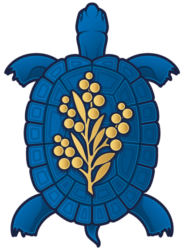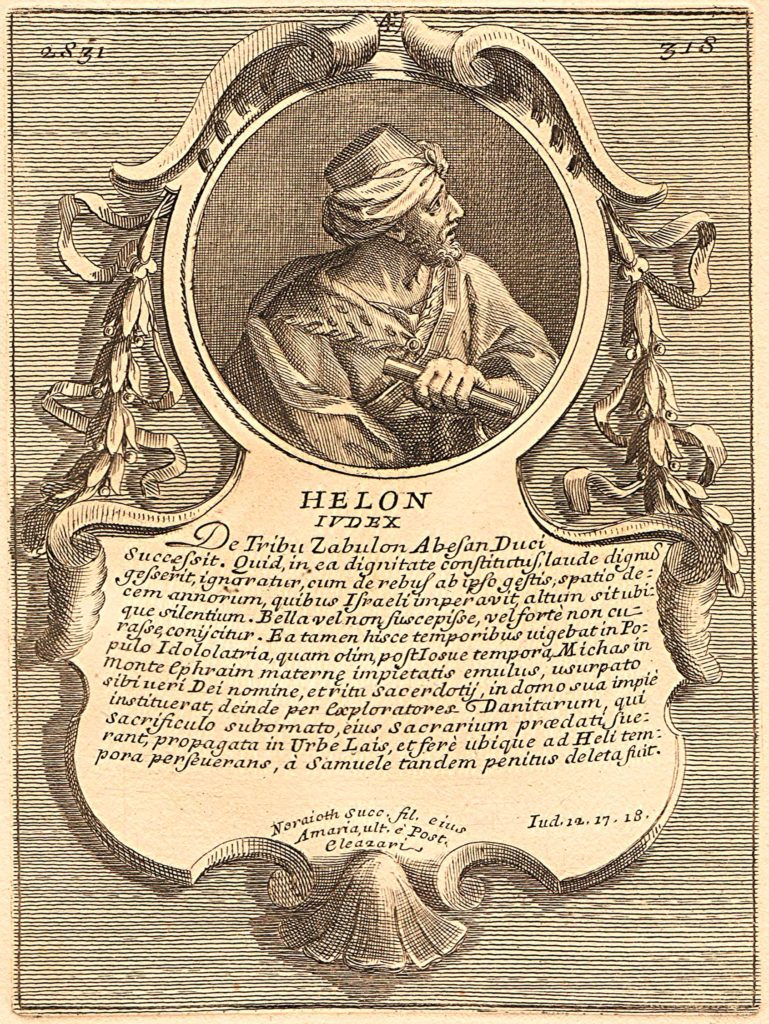
Archaeogenetics Proves Helons are Direct Descendants of Scythian Tribesmen.
What is Archaeogenetics?
Archaeogenetics is the study of the past using the techniques of molecular genetics; it is the application of genetics to archaeology. The term ‘archaeogenetics’ was coined in the 1990s by British archaeologist and palaeolinguist Professor Colin Renfrew (b. 25 July 1937) from the Greek ‘archaios’ (ancient) + ‘genetics’.
In archaeogenetics, information on the DNA of different ethnic groups from around the world is used to analyze prehistoric events and corroborate accounts from historical sources. The DNA data are reconciled with the findings of archaeologists, linguists, and palaeoanthropologists to shed light on the past.
The Independent Findings!
In 2018 the Archaeological Research Laboratory (Department of Archaeology and Classical Studies) at Stockholm University in Sweden and the Institute of Anthropology (Department of Human Evolutionary Biology) at Adam Mickiewicz University in Poland independently extracted and tested the ancient DNA from the teeth of a number of individuals identified as Scythians (specifically scy006, scy009, scy010, scy301, et al.) who lived between 600 – 290 BC (1) about those areas described by the ancient Greek historian Herodotus (c. 484 – 425 BC) and the first century Romano-Jewish historian Titus Flavius Josephus (c. 34 – 100 CE) et al. who wrote of the forest-steppe Royal Scythian Helon tribes (Fig. 1.).
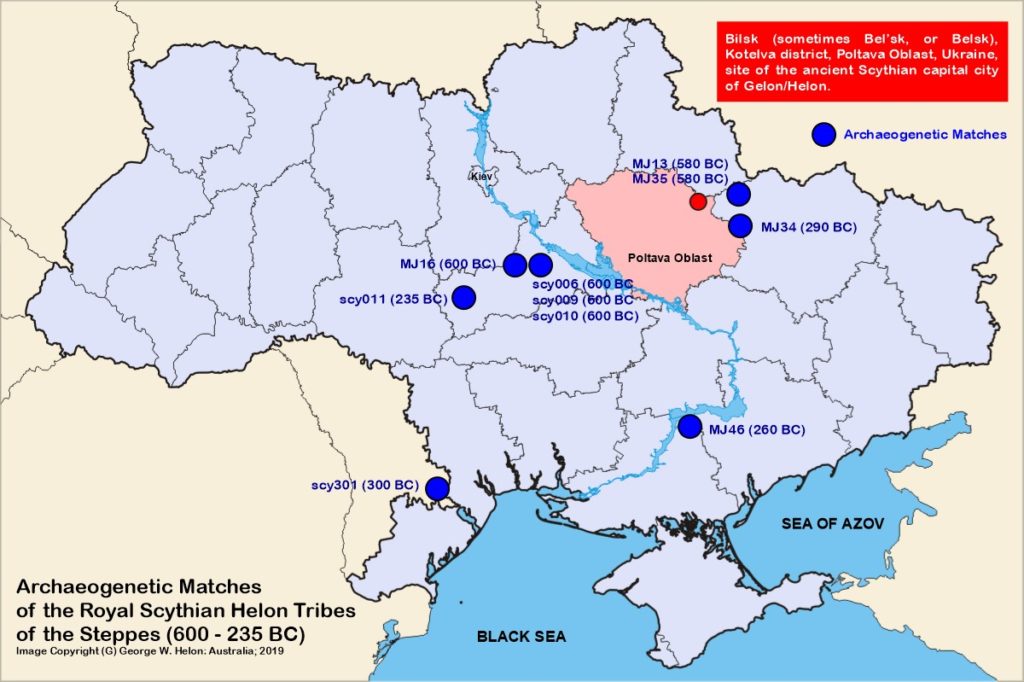
The remains analysed came from those areas where it is well documented that we Helons were known to have once frequented (see the two blue markers north of the Black Sea; specifically the darker one referenced Scythian 600 BC (X2), Fig. 2.) – areas where archaeology, anthropology, history, modern science, and genomic research are converging, authenticating and illuminating the annals of biblical and ancient history.
Read the full PRESS RELEASE here.

Eminent American professor of history, political science, and Chair of Ukrainian Studies at the University of Toronto Paul Magocsi wrote that: “the Scythians themselves also established fortified centers to coordinate their trade. [One of the] largest of these [was] Helon/Bil’sk” (2) the “capital of Great Scythia” (Schevchuk: 2005; p. 49.), Fig. 3.

Professor Vasyl Yakovych Schevchuk, Doctor of Economic Sciences, President of the International Dnipro (Black Sea) Fund, and former Minister of the Environment and Natural Resources of Ukraine also asserted that Helons were Scythians; he wrote that: “on the territory of Belske, in an ancient town (Poltava Oblast), which was the location of the legendary capital of the forest-steppe Scythian Helon tribes depicted by Herodotus (Fig. 4.), some relics have been found – an antique ring made by an Ionian craftsman, as well Phoenician perfumes (sic) phials.” (3)
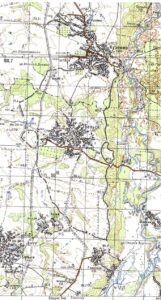
Schevchuk (2005; p. 29.) added that: “the lands along the Dnipro are saturated with the spirit of numerous civilisations that succeeded one another from the East as well as the West. Contemporary factual research will be of primary importance in determining the spiritual identity of the Indo-European cultural settlements, as well as the mysterious relationship between the Slavonic, Hindu, and Greek cultures. It will solve the riddle of the Scythian Hellenes, the mystery of the Helons of the Dnipro lands and their Dionysian cult, as well as other manifestations of Greek myths and rituals of unknown origin.”
Coupled with all of the extant biblical, archaeological, ancient, historical, cartographic, linguistic and genetic evidence, it can be concluded beyond reasonable doubt that Helons are definately direct descendants of Scythian tribesmen and warriors who (at the height of their power and influence) roamed from about China westwards to the Carpathian Mountains – the gateway to Europe.
Now most astonishingly there is an annual festival held each year at Belsk, Poltava in the Ukraine where people gather to commemorate, celebrate and pay homage to our HELON Scythian ancestors of aeons past.
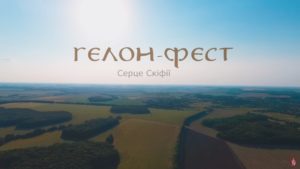
A World First!
What makes the HELON family archaeogenetic links to those identified ancient Scythian remains even more special and rare – a world first – is that HELON is the documented culture of the HELONIAN people, of the HELON tribe, of which its wooden-walled city was called HELONUS, where today there is held an annual HELON festival commemorating, celebrating and paying homage to our Royal HELON Scythian ancestors of aeons past; we not only bear the name HELON as our surname, but our DNA unequivocally matches the independently analysed and documented remains of individuals identified as Scythian tribesman from the exact areas written about by the likes of the ‘Father of History’, the Greek historian Herodotus et al.
That we Helons match ancient remains dating from 600 to 235 BC makes our family one of the world’s oldest and unbroken dynastic bloodlines with a ripe old age of just over 2600 years; predating most European royal and noble houses by hundreds of years.
The fact the Helon family’s lineage is 1700 years older than Her Majesty the Queen of England’s – which reckons its descent from Alfred the Great, King of Wessex and of Anglo-Saxons who died on 26 October 899 – is truly amazing.
Read the full PRESS RELEASE here and published NEWS ARTICLE here.
God, Science and the Bible – the ‘Missing Link’ is right here!
The Helon family’s biblical, ancient, Semitic, Ashkenazi, Hebrew, Greek, and Scythian ethnic origins are irrefutably proven by current genetic, DNA and archaeogenetic studies.
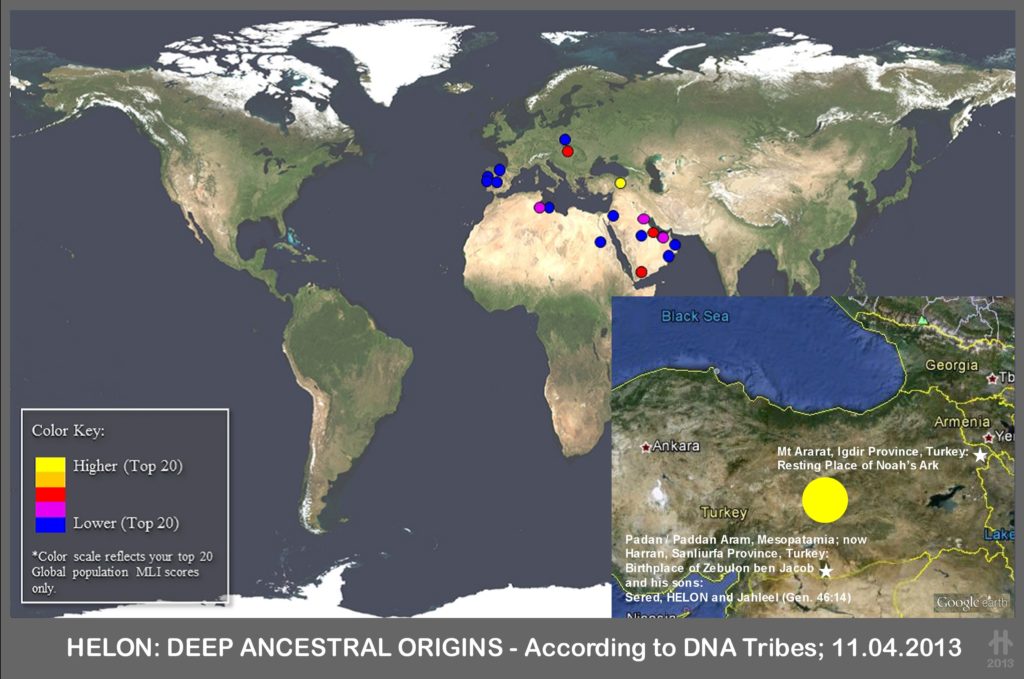
In fact, a post thread (Y-chromosomal analysis of common Jewish patronyms) that appeared on Eupedia in June 2014, alluded to the family Helon as being a biblical lineage, along with the Cohen and Levine families.
Interestingly too, an analysis of ancient and rare alles (variant forms of a given gene) undertaken in December 2018 further supports the already well-founded conclusion and well-documented biblical, archaeological, ancient, historical, cartographic, linguistic and other evidence that Helons were Scythians.
From the study it was found that Helons share 34.8% of their genome with Scythian and Indo-European cultures which once occupied the Pontic-Caspian Steppes throughout that area now geographically encompassing modern day Ukraine: Karasuk (10.5%), Andronovo-Srubnaya (9.1%), and the Yamnaya-Afanasievo-Poltavka (15.2%) – Poltava being the location of the legendary city of Helon (rendered Gelon in the Ukrainian and Greek languages) as described by the ancient Greek historian Herodotus.
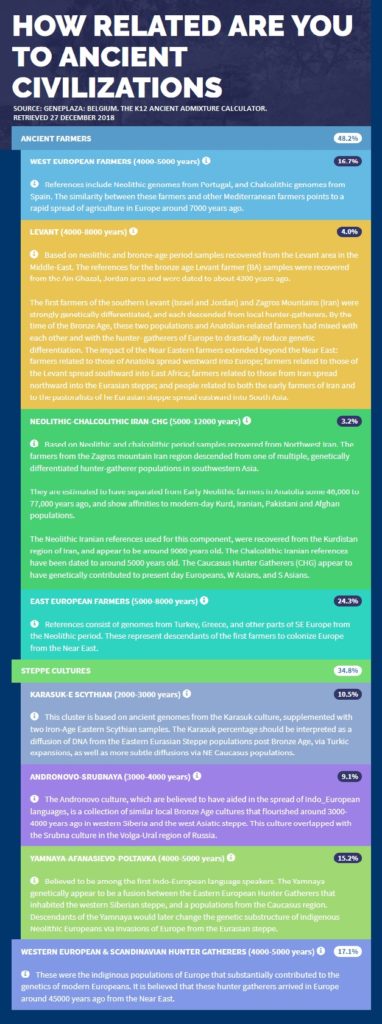
The ancient wooden-walled city of Helon written about by Herodotus is today being reconstructed at Bil’sk in the Poltava Oblast north of the Black Sea where the Helonians once roamed with their kindred Scythians – the Budini.

More recently in history, and before their exodus en masse from Europe and dispersal throughout the world to Australia, France, the United Kingdom, Holland and the United States, various Helon families were domiciled about Poland, Slovakia, Hungary, the Ukraine, the Middle East, Palestine, China and Mongolia.
After analysing my whole genome, the National Geographic’s Genographic Project was able determine and pinpoint the regional ancestry of the families Helon within the last six generations: Northern European 44%; Mediterranean 35%; Southwest Asian 17%, and Northeast Asian 3%.
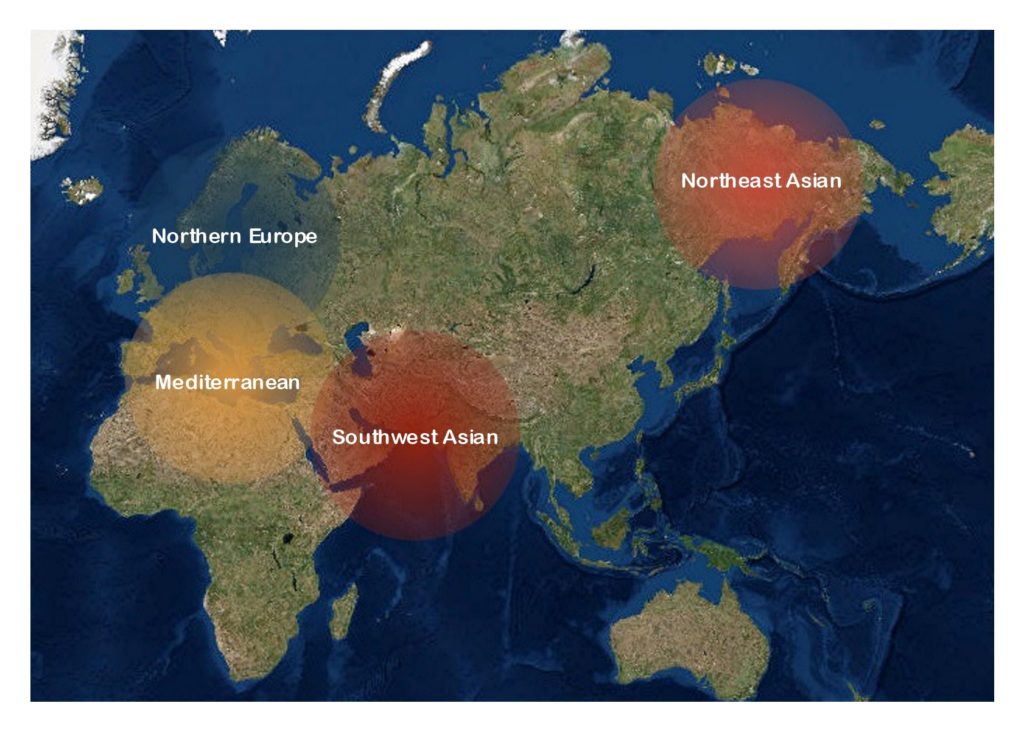
It is remarkable, that when applying data congruent to the Helon family in the creation of its infographic mapping of the three major episodes of ancient human migrations across the European continent (Hunter-Gatherers, Early Farmers, and Metal Age Invaders), Family Tree DNA (Houston) has intentionally or otherwise delineated the course of a number of notable events in biblical history most relevant to, and quantifying the prima facie evidence which supports the genetic, ethnic, ancient, and biblical origins of the Helon family.

Most Recent Ancestral Origins (MRAO)
Before emigrating to Melbourne, Australia in April 1970, my family lived about Swindon, Wiltshire, England (1969-1970); Wolverhampton, West Midlands, England (1957-1969); Zurawica, Przemysl, Poland (1948-1957); Bwana Mkubwa (Polish Displaced Persons Camp), Tanganyika (now Tanzania, 1943-1948), and with our kinsmen we lived about Mucznaja (Russian slave labour camp), Kotlas, Siberia (1940-1943); Krzywe, Radziechow, Poland (1936-1940); Pawlow, Radziechow, Poland (1905-1936), and Izdebki, Brzozow, Poland (1750-1905).
The most recent, and highest resolution population matches indicative of where the majority of Helon descendants reside today – the Middle East.
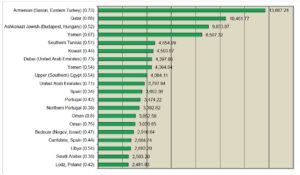
The Helon Family DNA Project
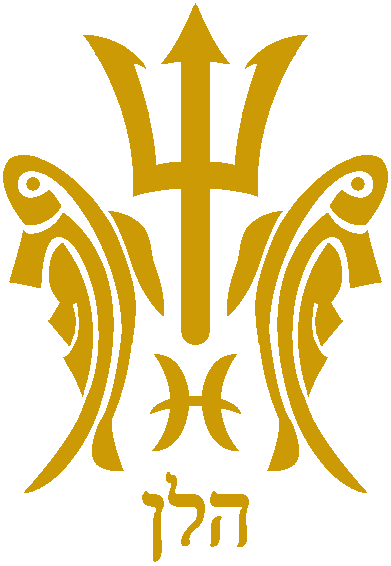
This DNA research project is open to ALL those persons throughout the world who proudly bear the surname Helon translated, transliterated and rendered in any of its many forms: Chjelyan, or Djilan in Chinese; Helan in Czech; Helon in English and Latin; Hélon in French; Gelon, or Γέλων in Greek; Chelon, Chêlôn, Khay-lone’, האֵלן ,הלן, or האֵלנ in Hebrew; Elon, Elonnak, Helonnak, or Kelon in Hungarian; Chelen, Chelon, Khelen, Khelon, Shelen, Shelon, Zhelen, or Zhelon in Lemko; Hoelun or Hulun in Mongolian (Latin script); Gehlen, Gelen, Gelin, or Гелен in Russian; Cielen, Czeleń, Czellen, Helhan, or Helhon in Rusyn; Jilan or Yilan in Turkic; Gelon, or Гелон in Ukrainian – with the common spelling in the Polish language (since the 15th century) being Helon, although the name can also be rendered as Chelon; the ‘C’ being silent.
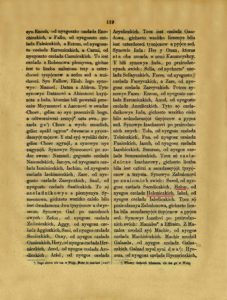
As there are so few Helon family Clans scattered about the World (albeit with some small concentrations), participants are encouraged to actively share that information and documents that they may have on their families Helon in order to establish an archive of substantiated proofs.
References:
(1) Krzewinska, M., et al. Ancient Genomes Suggest the Eastern Pontic-Caspian Steppe as the Source of Western Iron Age Nomads (Individuals scy303, scy009 and scy010). Science/AAAS. American Association for the Advancement of Science: Washington; Vol. 4; No. 10; 3 October 2018; pps. 3, 5, 9 & 10.
(2) Magocsi, Paul Robert. Ukraine: An Illustrated History. University of Washington Press: Seattle; 2007; p. 15.
(3) Schevchuk, V.Y., et al. Preserving the Dnipro River: Harmony, History and Rehabilitation. Mosaic Press: Ontario; 2005; p. 34, et al.
Connect with Me!
Copyright (C) George W. Helon: Australia; 2018-2025.
Now with SSL Certification for your Security!


